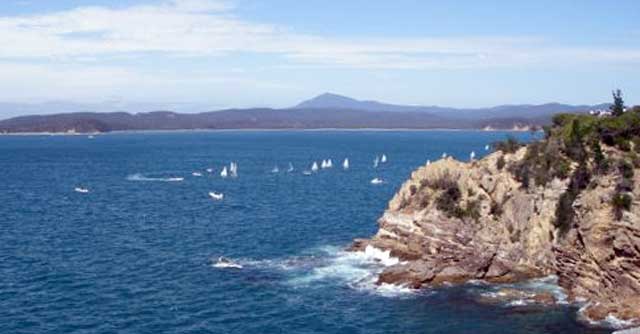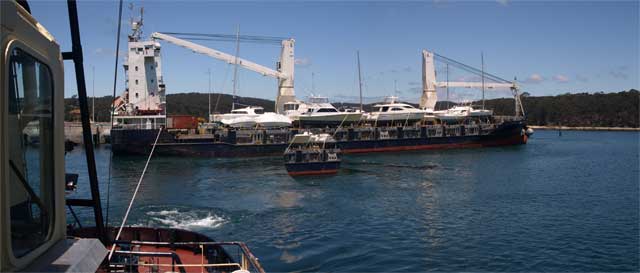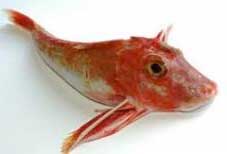The port of Eden lies in Twofold Bay on the south coast of New South Wales, just north of Cape Howe, where the coast swings west into Victoria.. Tall eucalypt forested hills drop steeply to azure waters, rocky headlands punctuate wide crescent beaches of golden sand. The East Australian Current flows south at speeds of up to seven knots bringing warm water from the tropics and delivering it into the cold waters of the Tasman Sea, a marine superhighway bringing tropical fish to southern latitudes. At its peak in February it moves a staggering thirty million cubic metres of water every second! The current terminates near Eden. The fishing here is legendary, one of the reasons friends of ours; – Chris and Sally – have built a house right on the beachfront, overlooking Twofold Bay.
They share with me a passion for eating one of my all time favourite denizens of the deep – the Yellowtail Kingfish.
In January, Jane and I pack up the Landcruiser and head over the mountains to pay them a visit. No different from any of our previous maritime excursions, our main raison d‘etre is to hunt, gather, harvest and feast on Neptune’s bounty. Well, that was the plan, but on a daily basis the reality was a bit different. When the fish weren’t biting, we fished with our wallets down at Eden harbour in the fish shop. On the wharf there is a bloke who sells fresh-farmed mussels, and the Sydney Rock Oysters fresh shucked from Lake Wonboyn are stunning. There are still wild oysters to be found growing on the rocks around the coast, although like wild mussels they are getting more difficult to find.
Our second day presented us with a tough decision. There were rumours that schools of yellowtail kingfish were taking bait off Mowarry Point, about five nautical miles south of Eden. It was also Ladies day at the Eden Yacht Club, 20-25 knots of breeze, an ambient temperature of 30 ° and the chance to sail on a new 34’Jenneau. The yellowtails receive a reprieve, and we spend the evening on deck drinking white wine and diving off the yacht into the crystal clear water of Twofold Bay.
The following day we were invited aboard a tugboat for he day. There were more rumours of yellowtail, but the chance of fulfilling a childhood fantasy was too much to resist. For the next few hours we chugged backwards and forwards across Twofold Bay. We pushed an Ecuadorian Cargo vessel out and pulled HMAS Darwin in. All that pushing and pulling sure stimulated the appetite, problem was we hadn’t caught any fish. Solution – the fish shop has some whole unfilleted red gurnard.
I reckon Gurnard is one of the most underrated fish on the market. With flathead now reaching $40 a kilo, Gurnard, with its sweet white flesh at seven bucks is a bargain – but DON’T TELL ANYONE. The unpopularity of gurnard my have something to do with its venomous spikes which can cause extreme pain and have been responsible for two deaths in Australia. Down at the boat ramp we encounter three blokes at the filleting bench butchering a massive 70kg Marlin they have just caught. Jane asks the first one if they know how to fillet gurnard. Gesticulating with his filleting knife towards his mate he replies, “No love, Barry might know. Barry immediately professes ignorance, and their mate Jeff holds out a massive fillet of fresh pink marlin towards me and says,” You can have this so long as we don’t have to fillet your bloody gurnard”. It’s a done deal. We retreat back to Chris and Sally’s for an entrée of marlin sashimi followed by gurnard lightly dusted in cornflour and sautéed with Indonesian kecap and lime rind. It’s a win all round!
I wake to the chimes of bellbirds and the sun streaming in beams through the eucalypts,. Out on Twofold Bay the water is the lightest of blue, so still the horizon is blending with the sky. A perfect fishing day, and Chris is champing at the bit to get at it. Within fifteen minutes the boat is gliding across Twofold Bay towards Ben Boyd National Park. In the distance a small flotilla of white specks are clustered off Morwong Point – the yellowtail are on!
The yellowtail kingfish or southern kingfish, Seriola lalandi lalandi, is a subspecies of yellowtail amberjack, which is found globally in temperate waters.
They are oceanic surface fish that congregate in schools around reefs, deep wharfs, bomboras and rocky headlands, usually during the warmer months. They love rough moving water, and once they strike, they are a tough fighter. The Australian record is a whopping 47.25 kg. The world record for spear fishing is 47.7 kg, held by an insane New Zealander, and I imagine it would have been akin to lassoing a snowmobile underwater!
The fishing ground presents a weird scene. There are all manner of vessels and rigs. Its mostly blokey, although there are a few women. There are a handful of professionals, and few father and son teams. They all share one thing in common – an obsession with kingfish.
Yellowtail kingfish swim in schools, they are a macho, tough fish that is fast moving. They don’t hang around in the same spot for long. The technique for catching them is a combination of luck and skill. The luck is dropping your hook onto the school. The skill is in how you set up your rig, and how you attract the fish to snap at your hook. The popular technique here is to lower your line jigging the rod up and down all the time until you reach the bottom, then to wind in and repeat the process all over again. So throughout the flotilla there are crowds of people all jigging away, spasming in homage to the fish. There is also the acceptable practice of dropping in on your neighbor. If you are pulling in fish, you won’t be on your Pat Malone for long.
And the one thing I didn’t mention was the effort required to land the fish. I’m beginning to think I’m out of luck when BANG, a kingfish strikes. There is nothing quite like the moment you first hook a kingfish. There is the strike, and then the fish takes off like a locomotive. The clutch on your reel screams as the fish heads for the deep. After letting the fish have it’s head you start winding, pulling the rod up, winding in frantically, then pulling again, being careful to keep the tension on the line. Your arms ache, the fish wheels around and gradually the finale closes as a dash of silver is finally spotted in the depths. A net is over the side, and the fish is in the boat, and immediately stashed in the ice box.
The excitement continues. You pull in and move to another spot. More strikes, more fish, more jigging, and always keeping a lazy eye on what’s going on in the other boats.
Its bloody hard work, but in one hour we have one broken reel, two blisters and twelve magnificent yellowtail, in the ice box, about 120kgs of fish all up. As hard as it is to leave the fishing ground while there is a run on, we have had enough. We wind in, stow the reels and head for Eden.
There is plenty of flesh on kingfish. It is akin to tuna, but a little milder, with its own unique flavour. Fresh it makes great sashimi, its firm flesh cut into steaks is ideal to grill, but I think the very best way to cook it is grilled with a simple Teriyaki marinade, with a side salad of Arame or potato wedges. Get the recipe here!







I just signed up to your blogs rss feed. Will you post more on this subject?
My site is on Low carb diet plan.
hello, love from finland. your post looks great. Mind if i quote it in my blog?